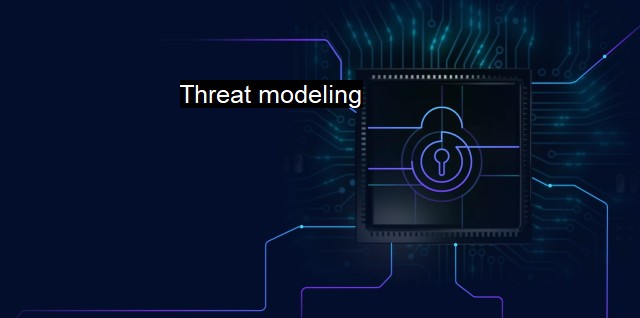What is Threat modeling?
Defending Against Cyberattacks: A Comprehensive Guide to Threat Modeling for Information Security
Threat modeling is a pathfinding process that permeates every aspect of security development, underlining a proactive approach to countering cybersecurity threats. It involves an organized and systematic process where potential threats, vulnerabilities, or attacks against computer systems are anticipated, identified, categorized, and prioritized in the field of cybersecurity and antivirus.It can be comprehended as the iteration of the phrase "know your enemy." The methodical framework employed allows the team to brainstorm on potential sources, openings, and areas where threats could originate and prepare safeguard mechanisms to counter, decrease, or neutralize their effects.
The essence of threat modeling is to comprehend the countermeasures needed to weaken an attacker while strengthening the protection system. It also aids in developing informed practical decisions in order to gain a finer perception on whether and when to build or buy security measures.
Contrary to many IT practices hinged on after-the-fact detection, threat modeling is a preemptive effort. The process initiates with an exhaustive understanding and description of system design, followed by the identification of possible threats and possible countermeasures to protect the system. there are three key steps to this process: Decompose the Application, Determine and Rank Threats, and identify countermeasures.
Decomposing the application means to break down the systems and applications into understandable, manageable chunks. It helps architects and managers to isolate the component parts of their new or exsisting systems into a mode that safeguards threats. The second step, determining and ranking threats, involves discerning the system vulnerabilities and acknowledging their triviality or seriousness. Lastly, countermeasures are identified - it is meant to stave off and deter threats found in the process.
The virtual threat environment is constantly redefining itself, but the methodologies of threat modeling can be grouped into four categories: attacker-centric, software-centric, asset-centric, or hybrid.
An attacker-centric model spots areas that are vulnerable to breaches by probing the system on what an assailant might target, and how. It considers the attackers’ purposes, skills, and resources. The asset-centric model scopes the analysis around explicit security attributes of system components, accounting for integrity, accessibility, and confidentiality of information. Software-centric models revolve around specific bits of system or software, while hybrid, as the name suggests, blends elements from other methods to suit particular situations.
This strategic tool is most effective when implemented at the initial stages of development which finds immense relevance in cybersecurity and antivirus. By infiltration, spyware, malware, viruses, phishing, DoS or DDoS attacks, and other cyber threats are intentionally warded off and combated actively through threat modeling.
a contextualized incorporation of threat modeling can result in maintained confidentiality, retained integrity, safeguarded information & general properties, averted service disruption, and assured information/utility availability. Advocate of the software security field concur on threat modeling as being among the most effective tools to mitigate potential security breaches. Regardless of whichever phase of software life-cycle, threat modeling, undoubtedly, sharpens the accuracy of risk-assessment, ideally mitigating, if not eliminating, system vulnerabilities.
The much-needed emphasis on robust software systems necessitates models that pre-empt attacks and strengthen the preventive layer long before damage ensues. Threat Modeling, in the world of cybersecurity and antivirus applications, focuses on just this - offering a methodical way to manage threats holistically and systematically, to guard against an increasingly sophisticated array of cyber threats. Hence, it would not be wrong to term it as the foundation base for efficient software security.

Threat modeling FAQs
What is threat modeling and why is it important in cybersecurity?
Threat modeling is a structured approach to identifying and evaluating potential threats, vulnerabilities, and risks to an application or system. It is important in cybersecurity because it helps organizations prioritize their resources and take proactive measures to improve their security posture. By identifying and addressing potential security risks early on, organizations can reduce the likelihood of a security breach and minimize the impact in case of a successful attack.What are the key elements of a threat modeling process?
The key elements of a threat modeling process include identifying assets and resources that need protection, identifying potential threats and vulnerabilities, assessing the impact of those threats, and selecting and implementing appropriate countermeasures. The process should be iterative and involve stakeholders from different parts of the organization to ensure a comprehensive analysis.How does threat modeling relate to antivirus software?
Threat modeling can help antivirus software vendors and users better understand the types of threats that may target their systems and the potential consequences of a successful attack. By analyzing the attack surface and identifying potential vulnerabilities, vendors can develop more effective antivirus solutions that can better detect and mitigate threats. Users can also use threat modeling to better understand the risks associated with different activities and make more informed decisions about how to protect their systems.Are there any best practices for conducting a threat modeling exercise?
Yes, some best practices for conducting a threat modeling exercise include involving stakeholders from different parts of the organization, using a standardized methodology or framework, starting with a high-level overview and gradually drilling down into more specific details, prioritizing risks based on impact and likelihood, and regularly reviewing and updating the threat model as new threats emerge.| | A | | | B | | | C | | | D | | | E | | | F | | | G | | | H | | | I | | | J | | | K | | | L | | | M | |
| | N | | | O | | | P | | | Q | | | R | | | S | | | T | | | U | | | V | | | W | | | X | | | Y | | | Z | |
| | 1 | | | 2 | | | 3 | | | 4 | | | 7 | | | 8 | | |||||||